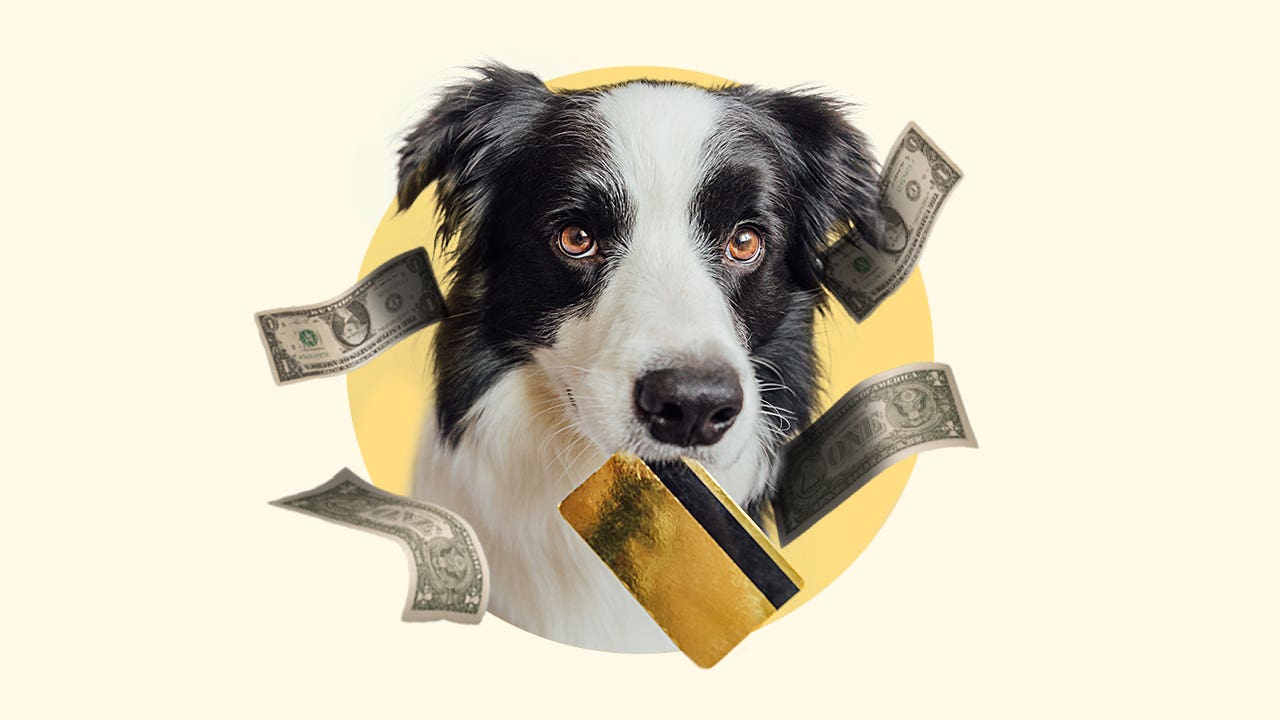Americans spent $4,800 on their pets last year, with no plans to cut back in 2024

The Bankrate promise
At Bankrate, we strive to help you make smarter financial decisions. To help readers understand how insurance affects their finances, we have licensed insurance professionals on staff who have spent a combined 47 years in the auto, home and life insurance industries. While we adhere to strict , this post may contain references to products from our partners. Here's an explanation of . Our content is backed by Coverage.com, LLC, a licensed entity (NPN: 19966249). For more information, please see our .
If you’re thinking about bringing a new pet into your family, you probably already know you need to adjust your budget for new expenses like food, treats and toys. (Accessories to make your new pet look extra cute in photos are optional, but encouraged.)
However, chances are, no matter how experienced you are in pet ownership, you’ll run into unexpected costs. You may do everything in your power to keep your pet healthy, but a dog will still eat something he shouldn’t have, or a cat will develop health problems and need to switch to a more expensive wet food.
Unexpected pet-related expenses can cost thousands of dollars, which is money many people don’t have on hand. Only 30 percent of U.S. adults increased their emergency savings between January 2023 and January 2024, according to a recent Bankrate survey.
Pet ownership should be fulfilling, not a financial struggle. Through a little planning and smart saving habits, you can be better prepared for whatever emergency your new pet throws your way. This is how much, on average, pets cost Americans each year — keep these figures in mind when budgeting for your new best friend.
Wagging tails and wet noses often pull our heartstrings, but in the long run, getting a pet should also be a financial decision. Animals come with an additional financial risk in the form of medical bills, food and liability concerns.— Shannon Martin | Bankrate Insurance Analyst
Bankrate’s insights on emergency expenses while owning a pet
- Americans’ emergency savings need a boost. 32% of U.S. adults have less emergency savings than they did a year ago. 9% had no emergency savings a year ago and have none now.
- A pet emergency could put people in debt. 35% of U.S. adults would go into debt to pay a $1,000 emergency expense: 21% would finance with a credit card and pay it off over time, 10% would borrow from family or friends and 4% would take out a personal loan.
- Losing income could be dire for pet parents. If they were to lose a primary source of income tomorrow, 66 percent of people would be somewhat or very worried about having enough emergency savings to cover their immediate living expenses for the next month.
The average cost of owning a pet can add up to nearly $5,000 a year
Americans really, really love their pets, so much so that they may pay thousands each year to keep them happy and healthy. Pet parents spent, on average, $4,800 on their animals in 2023, according to a MetLife survey of dog and cat owners.
That includes an average of $1,278 for food and treats, as well as an average of $176 for leisure splurges, such as cat trees, a swimming pool and, in one respondent’s case, a birthday party:
Pet parents’ average spending in 2023
| Expense | Average cost |
|---|---|
|
Note: Pet parents also spent $921 on average in 2023 on uncategorized expenses. Source: MetLife |
|
| Food | $633 |
| Treats | $645 |
| Toys | $585 |
| Clothes | $598 |
| Leisure splurges | $176 |
| Vet visits | $1,242 |
Keep in mind, though, these figures only represent dog and cat owners. Small mammals, reptiles, fish and other exotic pets aren’t typically as costly as dogs or cats, but they can come with their own financial hurdles.
“Enclosure updates have been the most expensive thing about my pets by far,” says Bankrate Credit Cards Editor Liza Carrasquillo. “I originally bought a snake that I thought was a male, but because it’s female, I’ll have to get her a much bigger enclosure than I currently have — and I’ll be dropping at least $600 on a custom PVC one once she outgrows her current terrarium.”

It doesn’t hurt to overestimate how much you’ll pay for pet care. Around two in five (41 percent) pet parents spent more money on their pets in 2023 than they originally anticipated, according to MetLife. If your pet ends up needing a specialized diet or medicine, or if you need to adjust your insurance policies because you own a pet, it can cost you much more than you originally budgeted for.

Bankrate Credit Cards Editor India Davis saw firsthand how common pet expenses can cost more than you planned.
“My dog was overweight, so he needed two packets of flea and tick medicine,” Davis says. “That was $750, twice the usual amount, plus specialty diet dog food, $110 a month. On the bright side, he lost 25 pounds and has much more energy.”
Unexpected costs are part of adopting a pet
Owning a pet can also lead to other indirect costs, beyond replacing your shoes after your new puppy chews them up. Bankrate Insurance Analyst Shannon Martin reminds pet owners that dogs add an additional level of risk to homeowners insurance and renters insurance policies. Some insurance companies exclude certain breeds or require dogs to complete a certified training program to be included in coverage.
“Adding a dog to your family is a huge responsibility,” Martin says. “With the average dog bite claim costing over $64,000, you will want to reduce your risk by properly training your dog early and being aware of your dog’s aggression triggers when guests come to your home.”
From food to renters insurance, pet parents are often adding a lot of expenses to their monthly bills. But no bill tends to be higher for animal lovers than the cost of a trip to the vet.
Veterinary care is the biggest expense when adopting a pet
Pet owners are now spending more to keep their furry pal healthy than they did before COVID-19 — sometimes hundreds of dollars more. The average spending on surgical vet visits, ER visits, boarding, grooming and other related costs increased from $1,788 in 2018 to $2,117 in 2022, according to a study of dog and cat owners by the American Pet Products Association (APPA).
Source: APPA
Source: APPA
Not everyone will need to pay for surgery or an emergency room visit for their pet, but unfortunately, it’s very common. Nearly one-half (45 percent) of pet parents said their pet went through a major health event in 2023, and 82 percent of them weren’t financially prepared for the cost of it, according to MetLife.
“We had to take our little man, Alfie, to the ER last January and he had to stay overnight due to liver toxicity poisoning,” says Bankrate Personal Loans and Debt Relief Writer Hanneh Bareham. “It cost us nearly $7,000. In January, we had to take him back in for a stomach issue that cost us $4,000. Also, he has to eat prescription food for his allergies and it’s crazy expensive. He’s a hot mess, but he’s cute.”

For many people, adopting a pet is priceless
No matter how high their bills are, pet parents will go to the ends of the earth for their furry companions. The vast majority (83 percent) of pet parents say, realistically, there’s no limit on what they’d spend to make sure their pet is happy and healthy, according to MetLife.
Bankrate U.S. Economy Reporter Sarah Foster knows that feeling well. She fell in love with her dog, Toby, when she first saw him at a New York City shelter in 2019. She knew her time with him would be short-lived; he was already 12 and had been diagnosed with a stage four heart murmur. Over the next four years, she estimates she paid $15,000 on treatments, medical care and emergency vet visits. He died in 2023, but like many pet parents, she feels that the time she spent with him was well worth the money.
“I realized love at first sight did exist. Little did I know, though, that senior dogs are a major investment,” Foster says. “I was lucky enough to have an amazing four years with my best boy, but it was just as much an emotional privilege as a financial one. We’ve since welcomed a new dog into our lives: Dolly, Toby’s adopted sister. But experience is the best teacher, and we now have pet insurance. We’ve already saved thousands.”

3 ways to keep expenses down when owning a pet
You don’t need to go into debt to be the parent of a healthy and happy pet. These three tips can help you prepare for anything your pet throws your way.
1. Open a savings account just for emergencies.
Because not everyone has thousands of dollars in their checking account for an emergency vet visit, consider opening a separate savings account dedicated solely to your pet. Prioritize saving every month, even if it’s only a small amount, to help you be better prepared for emergencies down the road.
2. Check which pet benefits you already have.
If you’re adopting a pet for the first time, you might be surprised to discover you already have pet benefits you didn’t know about. Ask your employer if your workplace offers pet benefits like pet insurance, and check if you can add pet coverage with your insurance providers. With some car insurance providers, like Progressive and Metromile, you can add coverage that provides $1,000 towards vet bills if your cat or dog is injured in a car accident, according to Martin.
3. Consider pet insurance.
Pet insurance is an important tool to lower the cost of expensive vet visits, and it often costs as little as $50 a month or less per pet. The average annual premium for accident and illness coverage was $640.04 per dog in 2022, according to the North American Pet Health Insurance Association (NAPHIA). The average annual premium for accident and illness coverage was $387.01 per cat that same year.
Keep in mind: Unlike human health insurance, most pet insurance plans require you to pay upfront, before reimbursing you for a certain percentage of the bill later. An emergency savings account is still an important tool for paying vet bills.
“If you are nervous about the cost of pet insurance, shop around and get free quotes just like you do for your auto insurance,” Martin says. “In fact, many big name car insurance providers offer pet insurance and some, like Allstate and AAA, can bundle your policies for a discount or have reimbursement plans to make the insurance more affordable.”
FAQs
-
Americans spent $4,800 on their pet in 2023, according to MetLife.
-
Adoption fees will differ depending on your local shelter. Fees range from $50 to $350, according to Chewy. Shelters may waive their adoption fees when they hit full capacity.
-
Depending on the service needed, a vet visit can cost an average of anywhere between $150 to $5,000 for a dog, or $150 to $3,000 for a cat, according to MetLife.
Methodology
The study on emergency savings (that was conducted January 2024) was conducted by SSRS on its Opinion Panel Omnibus platform. The SSRS Opinion Panel Omnibus is a national, twice-per-month, probability-based survey. Data collection was conducted from January 19 – January 21, 2024 among a sample of 1031 respondents. The survey was conducted via web (n=1001) and telephone (n=30) and administered in English (n=1005) and Spanish (n=26). The margin of error for total respondents is +/- 3.6 percentage points at the 95% confidence level. All SSRS Opinion Panel Omnibus data are weighted to represent the target population of U.S. adults ages 18 or older.
The study on emergency savings (that was conducted December 2023) was conducted by SSRS on its Opinion Panel Omnibus platform. The SSRS Opinion Panel Omnibus is a national, twice-per-month, probability-based survey. Data collection was conducted from December 15 – December 17, 2023, among a sample of 1036 respondents. The survey was conducted via web (n=1006) and telephone (n=30) and administered in English (n=1010) and Spanish (n=26). The margin of error for total respondents is +/-3.6 percentage points at the 95% confidence level. All SSRS Opinion Panel Omnibus data are weighted to represent the target population of U.S. adults ages 18 or older.
Related Articles



